ABSTRACT
Recycling can be a viable option in the waste management of many materials. Noting the increasing volumes and difficulty in the disposal of wastes from rubber tyres, this paper discusses test results of use of recycled tyres in concrete for possible application in the construction industry. In 2008, around one billion end-of-life tyres (ELTs) were being produced globally each year. As a possible means of disposing the tyres, it is proposed to use rubber tyres as coarse and fine aggregate in concrete. Tyres cut into pieces with maximum size of 20 mm to use as coarse aggregate, and crumb rubber tyres used as fine aggregate. The replacement of the rubber tyres aggregates in concrete was done in three phases. In the first phase, fine rubber tyres aggregates were used to replace 50% of the normal sand. Secondly, coarse rubber aggregates tyres were used in the replacement of 50% of the normal gravel. Finally, both fine and coarse rubber tyres aggregates were used to replace the sand and gravel by 25, 50, 75 and 100%. Compressive strength, splitting tensile, and flexural strength tests were conducted according to the various BS codes. Although concrete made from tyres had lower strength than the normal concrete, it had elastic failure behaviour. It did not collapse completely when tested. The cohesiveness was an advantage for using it in places such as landscaping, sports field ground, architectural finishing, and other engineering applications. This paper also demonstrated the variation in the compressive strength of the non-conventional concrete when the BS and ACI methods are used in the design of the mix.
Key words: Recycling, rubber tyres, compressive strength, tensile test, flexural strength.
Although some countries have a good recycling process of wastes, others have failed in management and re-cycling of waste materials. Annually about 1.5 billion new tyres are produced (Hoornweg et al., 2009), some of which are recycled after use. A 2003 report cited by the U.S. EPA stated that markets ("both recycling and beneficial use") existed for 80.4% of scrap tyres, about 233 million tyres per year. The report further predicts a total weight of about 2.62 million tonnes (2,580,000 long tons; 2,890,000 short tons) from tyres annually.
In Kenya, 1.9 million waste rubber tyres were produced in 2011 (Otieno, 2015). That amount goes to different utilizations (5% stored, 5% fuel, 10% material recycling, 30% dumping, and 40% open burning for recovering steel). These percentages represent the final destination of the tyres after becoming waste (Bohm and Partners, 2011). 10.2% of the total generation of wastes are plastic and rubber (Hoornweg et al., 2009). This percentage is significant and makes studies of the tyres waste interesting and necessary. It is also known that the amount of disposable rubber tyres which come from diverse resources is extensive and not used (Batayneh et al., 2008).
This study is meant to provide ways of recycling rubber tyres by utilizing it as aggregates in concrete and establishing its technical viability for use in the building construction industry. The reduction of using natural resources to produce concrete is expected to be very beneficial. Normally, the compressive strength, flexural and splitting tensile strengths of the concrete decrease when the amount of rubber tyres increases in the mix. And when the amount of the tyres ingredient is small, the splitting tensile strength increases by 7% (Grinys et al., 2012).
Grinys et al. (2012) found some increase in the splitting tensile strength and attributed that to the adhesion between the cement paste and the crumb rubber. Although the compressive strength is lower than the conventional concrete, the absorption of the plastic energy is higher. It has also been noted that as the percentage of the rubber tyres aggregates increase, the weight of the concrete decreases (Neil and Senouci, 1994). Furthermore, the compressive strength decreases, if the rubber tyres aggregates are used to partially replace the normal ballast (Otieno, 2015). Hence, the use of rubber tyres has not been recommended in the structures where high compressive strength is needed.
Grinys et al. (2012) and Neil and Senouci (1994) used the rubber tyres as fine aggregates in concrete with different added percentages, and showed that strength and the weight were decreasing. (Batayneh et al., (2008) showed that the compressive strength and the splitting tensile strength reduced, when the normal sand was replaced with crumb rubber. Because of this, it has complied with the requirement of lightweight concrete.
Batayneh et al. (2008) replaced the normal sand by crumb rubber tyres. They observed a decrease in compressive strength, splitting tensile test and workability. Other authors studied the effect of rubber in self-compacting concrete and noted that it helped in binding the rubber phases (Bignozzi and Sandrolini, 2006). Lu et al. (2015) relates the observed decrease in the strength of the concrete to the local imperfections in the cement hydration. They showed that the rubber disturbed the water transfer to generate waterways (Lu et al., 2015). Most of the previous studies have investigated the partial replacement of the rubber tyres as aggregates (up to 40% replacement of the normal aggregates). This paper explores the high replacement of the rubber tyres as fine and coarse aggregates. It investigates the possibility of using it in the construction industry such as; landscaping, sports field ground, architectural finishing, and other engineering applications.
Materials
The target concrete was class 25 with use of Portland cement CEM I 32.5. River sand passing sieve No. 5 mm and crushed stone with maximum size of 20mm were used. Waste rubber tyres were cut manually into a size less than 20 mm. Grading of the sand and crumb tyre aggregate were graded to BS 812-103.1/2 and ASTM C33-03 and the results, which are within upper, and the lower limits are as shown in Figure 1 and 2 for fine and coarse aggregates respectively. Requirements specify that good grading of the fine aggregate should be located between the lower and the upper limits. Grading of both sand and fine rubber tyres fall within the grading limits. Dry-rodded density of the coarse rubber tyres aggregates was found to be 709 kg/m3. Also, the fineness modulus was 4.86. The specific gravity was 1.1 and 0.8 for coarse and fine aggregates respectively. The moisture content was carried out according to (BS 812-109, 1990).
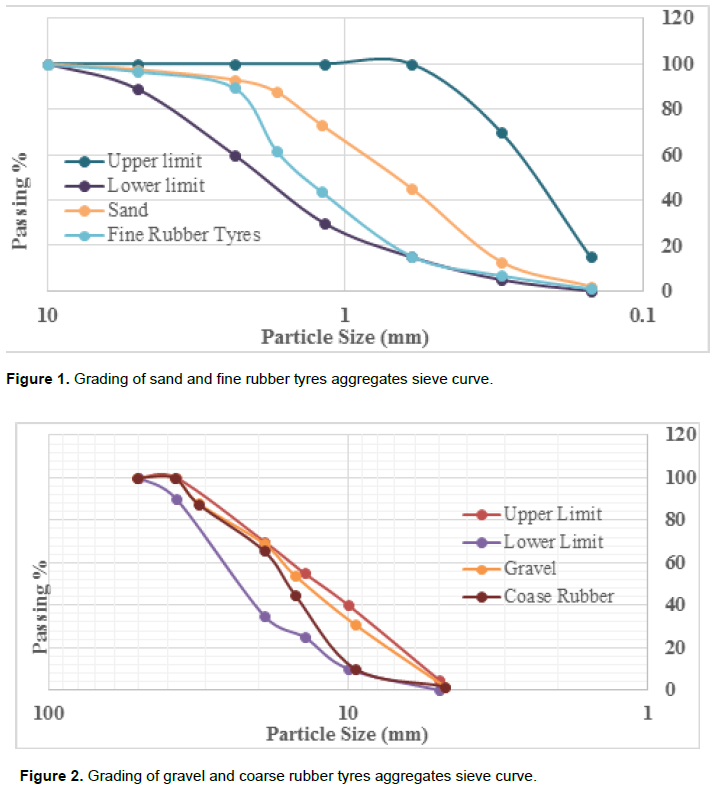
Although, fine rubber tyres aggregates grading met the requirements, its mechanical properties were very weak. In Table 1, Aggregate Crushing Value (ACV) of the coarse rubber tyres is 0.02, and Aggregate Impact Value (AIV) is 0.004. BS 812-112:1990 stated that if the AIV is more than 30%, the results should be treated with caution. Also, According to IS: 2386 (Part IV) - 1963, if the Aggregate Crushing Value (ACV) is more than 30%, aggregates should classify as weak aggregates. ACV and AIV values indicated the weakness of the strength, toughness, and hardness of the rubber tyres particles. In addition, normal aggregates have more dry-rodded and dry-loss densities than the rubber tyres particles (BS 812 Part 2, 1995). Thus, the mix needs more quantity of rubber tyres aggregates to replace the gravel. This has therefore raised the issue of the big volumetric percentage of the rubber tyres that have substituted normal aggregate in the mix. Additionally, rubber tyres particles have high elasticity than the conventional aggregate and low unit weight. These properties have influenced the characteristics of the concrete.

Test methods
The mix design of the concrete followed DOE method and ACI 211.1-91. Concrete class 25 has not been included in the ACI 211.1-91. Thus, the charts and tables were interpolated to obtain the specific strength. The curing of specimens followed (BS EN 12390-2:2009). The Compressive strength test was done using both 150 mm x 150mm cubes and 300 mm x 150 mm cylinders in accordance with (BS 1881-116: 1983) and (ASTM C39). Table 2 illustrates the proportions of the concrete which were obtained from the mix design for both methods. The water-cement (W/C) ratio did not change in the two methods. Obviously, ACI 211.1-91 has more cement content than DOE method. But the amount of the aggregate is more in the DOE than the ACI 211.1-91.
Test program
The replacement of the rubber tyres particles as aggregates in the conventional concrete was undertaken in three phases. In the first phase, fine rubber tyres aggregates were used to replace 50% of the normal sand. This replacement was done to check the influence of the fine rubber tyres in the behaviour of the normal concrete. The second phase consisted of 50% replacement of normal gravel by coarse rubber tyres. Under each of the replacement; compressive, flexural, and splitting tensile strengths tests were done. The third phase comprised of inclusion of replacement of the sand and the gravel by fine and coarse rubber tyres in different percentages; 25, 50, 75 and 100%. The three phases proportions were as illustrated in Table 3. All samples were cured for 7 days (BS EN 12390-2:2009). In all the phases, the mixes were tested for density, slump and compressive strength. The flexural strength and the splitting tensile strength tests were carried out when both sand and gravel were replaced by 50% of fine and coarse rubber tyres aggregates respectively. Figure 3 shows the compressive strength, splitting tensile strength and flexural test setups respectively. The splitting tensile strength and flexural strength tests followed (BS EN 12390-5: 2009) and (BS EN 12390-5: 2009).
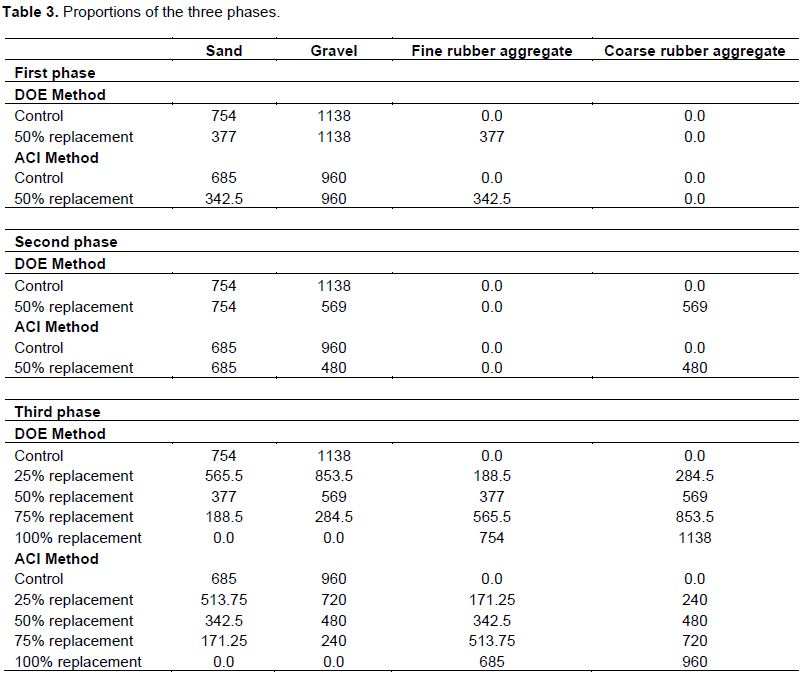
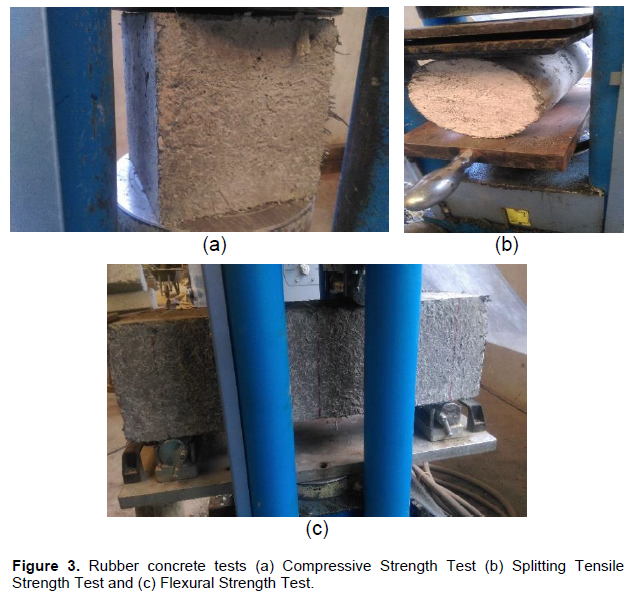
Thus, splitting tensile strength was tested using 300 x 150 mm cylinder. Beams of 150 x 150 x 450 were tested under four-point load.
Phase one
Test results for phase one are shown in Table 4. It can be seen from the Table that the density of the control (0%) is 2330 kg/m3 for BS method, and it is 2212 kg/m3 for the rubberized concrete. Cylinders gave density of 2360 kg/m3 for control, while the rubberized concrete gave 2026 kg/m3. Obviously, the density of the rubber concrete in BS decreased by 5%, and in ACI method, the density was 15% less.
In addition, the slump of the rubber concrete in BS method is 25.0 mm compare with the control which is 27.9 mm. Slump was changed slightly. While the ACI method gave slump of 65 mm and 45 mm for the control and the rubberized concrete respectively. Clearly, the slump in ACI method dropped by 30% of the control.
The compressive strength as Table 4 showed decreased significantly in both BS and ACI method. The concrete in BS method lost up to 80% of the strength, when the fine rubber tyres aggregates were added. In the ACI method, the rubberized concrete strength dropped by 85% of the control strength.
Phase two
Table 5 illustrates the tests results of phase two. The density of the rubberized concrete is 2119 kg/m3 in BS method, and 1869 kg/m3 in ACI method. In BS method, the density reduced by 10%, while in ACI reduced by 20%. Additionally, the slump decreased, when the rubber tyres aggregates were added in both BS and ACI methods. Similar to phase one, the strength of the rubberized concrete dropped significantly in both methods. The concrete lost 80% of the control strength in BS method, and 85% of the control strength in the ACI method.

Phase three
Phase three results are shown in Table 6.Strengths values for the three tests decreased with increase in the rubber tyres aggregates. Generally, the density of rubberized concrete was decreased by 15%. In addition to that, there was a slight change in the slump for replacements of 0 to 25%, but beyond this percentage the slump changed significantly. The higher the replacement with rubber, the lower the workability. The rubberized concrete has very low strength in comparison with the normal concrete in both methods. In Figure 4, it is obvious that there is a big drop in the curve between the 0 and 20% replacement. The strength was changing slightly after the 25% replacement for both methods.
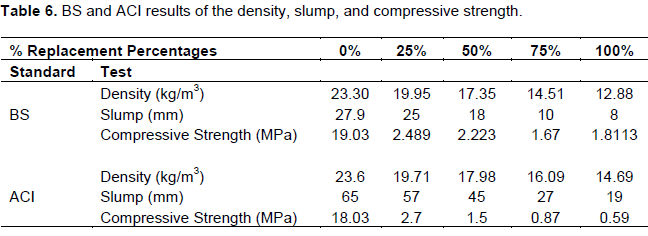
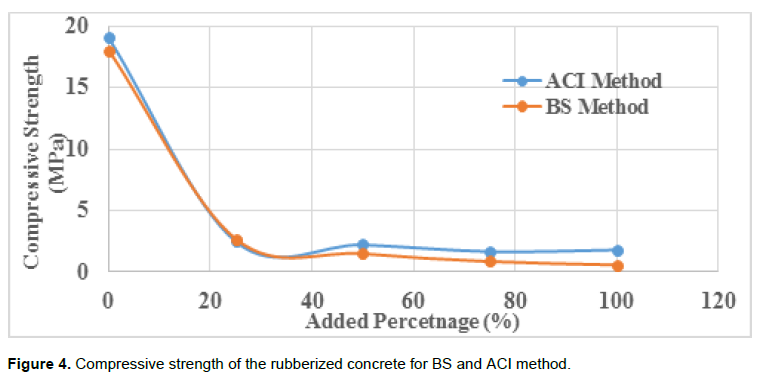
Flexural and splitting tensile strengths
The sand and gravel were replaced by 50% of fine and coarse rubber aggregates to check the flexural strength and splitting tensile strength. Table 7 illustrates that the flexural strength is 1.22 MPa, while the splitting tensile strength is 1.4 MPa. The flexural strength dropped by 65% of the control, and the splitting tensile strength was reduced by approximately 50% in comparison with the normal concrete. It was observed that at ultimate failure of the specimens, the shape of the specimens remains generally intact. This is noted as seen in Figure 5. The cohesiveness of the rubberized concrete increases with increase in the amount of the rubber tyres in the concrete. Furthermore, the samples were found to be still cohesive after repeating the compressive strength test many times. That extreme elasticity produces high resistance to crashing.
From the experimental results, the density decreased with increase in the amount of the rubber particles in concrete for both the BS and ACI methods. That is due to the light weight nature of the rubber particles.
The slump of the fresh rubberized concrete also decreased with increase in the amount of the rubber in concrete for both BS and ACI method. This is because of the replacement by rubber tyres aggregates was done volumetrically. That is, batching was done by volume, hence, there was a lot of rubber in concrete thereby affecting the quantity of water in the mix.
The strength of concrete depends on the amount of water in the mix. In this case, the rubber particles occupied more volume in the mix making more water within the mix available for the hydration reaction, lowering the strength. In addition, the rubber particles did not have enough strength to sustain the load, and that weakness was observed when the rubber aggregates were tested.
The flexural strength reduced, when the rubber tyres were used. The bond between the rubber particles and the cement paste was weak. This is probably because cracks occur on the surface between the rubber particles and the cement paste. Also, the splitting tensile strength for the rubberized concrete is reduced compared to normal concrete.
Finally, the rubberized concrete did not fail completely under the load. The shape of the specimen remains cohesive. This is because of the rubber particles are ductile. Moreover, the rubber particles have high value of wear, which increase the resistance to crashing of rubberized concrete Therefore, it can sustain more deformation, but with less compressive strength. Some applications such as footpaths do not need that high values of strength and are not subject to bending. The cohesion gives the advantage of making use of this type of concrete where lower strengths are needed. It can also be used as architectural finishing as long as its unit weight is light. In such a case, the use of the natural sand and gravel will reduce.
Based on the laboratory experimental research and the type of rubber tyres that have been used in this study, the following findings were made:
1) Compressive strength of rubberized concrete is suitable for footpaths. At lower replacement, the strength was about 5 MPa which it could be enough.
2) The reduction in strength is also accompanied by reduction in the density of the concrete. The rubberized concrete has light weight in compare with the normal concrete. It was reduced by 15% which could be an advantage in the architectural finishing.
3) The plastic energy of the rubberized concrete increasing proportional with the amount of rubber in concrete.
4) Also, the resistance of failure increasing proportionally with the amount of the rubber in concrete. The plastic energy and the resistance of failure gave this concrete an advantage for using it in sports field especially in tennis field, and others such as Basketball and Volleyball.
5) The flexural strength decreased by 65% with increase in the added percentage of the rubber tyres. Thus, rubberized concrete did not sustain bending.
6) Splitting tensile strength also reduced up to half of the strength of the control.
The authors have not declared any conflict of interests.
REFERENCES
|
ACI 211.1-91, A. C. (1997). Standard Practice for Selecting Proportions for Normal Heavyweight, and Mass Concrete, ACI 211.1-91. Manual of Concrete Practice, (Reapproved), 1-38.
|
|
|
|
ASTM C33 /C33M-16, A. commitee. (2000). ASTM C33 / C33M-16, Standard Specification for Concrete Aggregates.
|
|
|
|
Batayneh MK, Marie I, Asi I (2008). Promoting the use of crumb Rubber Concrete in Developing Countries. Waste Manag. 28(11):2171-2176.
Crossref
|
|
|
|
Bignozzi M C, Sandrolini F (2006). Tyre rubber waste recycling in self-compacting concrete. Elsevier Ltd., Five.
Crossref
|
|
|
|
Bohm and Partner (2011). Strategic Alliance (PPP) with the Cement Industry and Tyre Manufacturers and Dealers in Kenya. Germany: INTRASTRUKTUR & UMWELT.
|
|
|
|
BS 812 Part 2 (1995). Testing aggregates. Methods of determination of density. England: British Standard Institution.
|
|
|
|
BS 812-103.1. (1985). Testing aggregates. Methods for determination of particle size distribution. England: British Standard Institution.
|
|
|
|
BS 812-112. (1990). Testing aggregates. Methods for determination of aggregate impact value (AIV). England: British Standard Institution.
|
|
|
|
BS EN 12390-2. (2009). Testing hardened concrete. Making and curing specimens for strength tests. England: British Standard Institution.
|
|
|
|
Grinys A, Sivilevi H, Daukšys M (2012). Tyre Rubber Additive Effect on Concrete Mixture Strength. J. CIVIL ENG. MANAGE. Ten.
Crossref
|
|
|
|
Lu C, Chang J-R, Maw TL (2015). Use of waste rubber as concrete additive. (April 2006), 68–76.
View
|
|
|
|
Neil NE, Senouci AB (1994). Rubber-tire particles as concrete aggregate. ASCE, Nineteen. 5(4):478-496.
|
|
|
|
Otieno OV (2015). Strength Characteristics of Rubber Derived Concrete. Kenya: University of Nairobi.
|